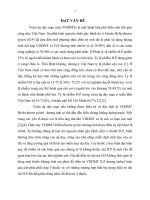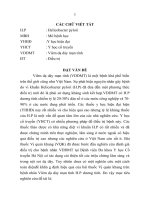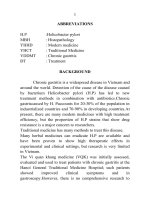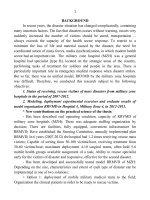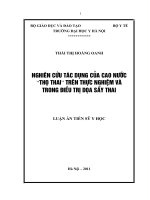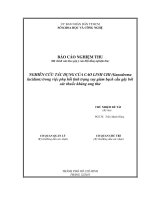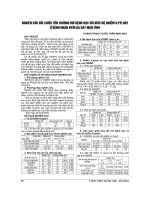nghiên cứu tác dụng của cao lỏng vị quản khang trên bệnh nhân viêm dạ dày mạn tính helicobacter pylori dương tính (tóm tắt tiếng anh)
Bạn đang xem bản rút gọn của tài liệu. Xem và tải ngay bản đầy đủ của tài liệu tại đây (500.85 KB, 28 trang )
1
ABBREVIATIONS
H.P :Helicobacter pylori
MBH : Histopathology
YHHĐ : Modern medicine
YHCT : Traditional Medicine
VDDMT : Chronic gastritis
ĐT : Treatment
BACKGROUND
Chronic gastritis is a widespread disease in Vietnam and
around the world. Detection of the cause of the disease caused
by bacterium Helicobacter pylori (H.P) has led to new
treatment methods in combination with antibiotics.Chronic
gastriscaused by H. Paccounts for 20-30% of the population in
industrialized countries and 70-90% in developing countries.At
present, there are many modern medicines with high treatment
efficiency, but the proportion of H.P strains that show drug
resistance is a major concern to researchers.
Traditional medicine has many methods to treat this disease.
Many herbal medicines can eradicate H.P are available and
have been proven to show high therapeutic effects in
experimental and clinical settings, but research is very limited
in Vietnam.
The Vi quan khang medicine (VQK) was initially assessed,
evaluated and used to treat patients with chronic gastritis at the
Hanoi General Traditional Medicine Hospital; such patients
showed improved clinical symptoms and in
gastroscopy.However, there is no comprehensive research to
2
confirm the effects of Vi quan khang medicine on the patients
with chronic gastritis caused by H.P.Therefore, this research
was conducted with the following two objectives:
RESEARCH OBJECTIVES
1. Research on acute toxicity, semi-chronic toxicity and
other pharmacological effects of VQK syrup on
experimental animals.
2. Research on the treatment effects of VQK syrup on
patients with chronic gastris caused by H.P.
NEWCONTRIBUTIONSOFTHETHESIS
Scientific works were systematically reviewed both pre-clinical
and clinical on the traditional medical remedy for the treatment on
patients with chronic gastritis caused by H.P.
The research results showed that oral VQK syrup is a highly safe
analgesic and protectsthe gastric mucous membrance while
eradicating H.P in experimental settings and on patients. No
undesirable clinical effects were detected on patients.
The research on the application of traditional medicine in the
treatment of positive Helicobacter pylori contributes to clear
traditional medicine theory and gradually modernize traditional
medicineand it is the work with practical scientific significance.
Notably, Vietnam is a country with a long history of using
traditional medicine for public health care, thus the results of the
thesis is new and very practical contribution.
3
THESIS STRUCTURE
The dissertation is 112 pages excluding appendices and
references, and consists of 4 chapters, 36 tables, 5 graphs, 6
illustration pictures, 127 references (54 Vietnamese, 39 English,
34 Chinese) and Appendix .
The thesis layout includes: 2 pages of introduction, 32 pages of
overview, 15 pages of research subjects and methods, 28 pages of
research results, 32 pages of discussion, 2 pages of conclusions, 1
page of recommendations and 5 articles with content relavant to
the thesis has been published.
CHAPTER 1. OVERVIEW
1.1. CHRONIC GASTRITIS IN VIEW OF MODERN
MEDICINE
Chronic gastritis is defined by gastric mucosal lesions
caused by many different reasons, which are divided into 3
main types. Helicobacter pylori bacteria accounts for 70% -
80% of all gastritis in developing countries.The most accurate
method todiagnose chronic gastritis is based on histopathology.
There are many different classifications of stomach that have
been proposed and applied so far such as classified by Kimura,
Whitehead, Sydney System, OLGA, etc. Each classification has
its own advantages and disadvantages. At present, the
endoscopic and gastrointestinal surgery centers in Vietnam are
assessing the results basedon the guidelines of the Sydney
classification system introduced in 1990 and completed in 1994
and has been widely applied in the world.
4
Chronic gastritis caused by H.P has been mainly been treated
using internal medicine methods. H.P is hard to eradicate
because it is located in the mucous membrane of the gastric
mucosa where the drug is not diffused to or diffused in low
concentrations and thus unable to eradicate the bacteria.
HP is a slow-growing bacterium, requiring coordination and
prolonged use of the medicine. To achieve high effects of
treatment, a strong antacid should be used. Thus, proton pump
inhibitors PPIs (Proton Pump Inhibitor) are commonly selected.
For the antibiotics: Antibiotics should withstand the acidic
environment and increase resonant effects effectiveness and
stay in the stomach as long as possible. Thus, the oral
antibiotics are least resistant to bacteria
At present, there are many modern medicines with high
treatment efficiency, but the proportion of H.P strains that show
drug resistance is a major concern to researchers.
The HP eradicationis not simply taking some antibiotic
regimens, the effective treatment regimens for chronic gastritis
caused by H.P will be triple antibiotics. For the cases that first
regimenon HP eradicationfailed and then the 4 drug regimens
should be used.
1.2. CHRONIC GASTRITIS IN VIEW OF TRADITIONAL
MEDICINE
Chronic gastritis belong to phenomenon “Vi quan Thong”of
traditional medicine and is functional disorders of the Can, Ty
and Vi due to many different reasons.There is no name of
5
Helicobacter pylori in traditional medicine, but refer to the
disease it caused, this is a kind pathogenic miasma.
Many herbal medicines can eradicate H.P are available and
have been proven to show high therapeutic effects in
experimental and clinical settings, but research is very limited
in Vietnam.
1.3. OVERVIEW ON MEDICINE RESEARCH
VQK medicine combines:
Rhizoma Coptidis 12g
Fructus Evodiae rutaecarpae 4 g
Rhizoma Typhonii trilobati 12g
Pericarpium Citri deliciosae 8 g
Poriae 12g
Radix Glycyrrhizae 6 g
Tuber Corydalis 12 g
RhizomaCurcumaezedoariae 12g
Os Sepiae 12g
The modern research results showed that there are some
remedies in the VQK are able to eradicate H.P in experiments.
Medicine has been used to treat patients with chronic gastritis
in clinical and initially improved some clinical symptoms such
as epigastric pain, abdominal distention full, belching, and
heartburn.
CHAPTER 2
RESEARCH MATERIALS, SUBJECTS AND METHODS
6
2.1. RESEARCH MATERIALS
The Research medicineis VQK which was prepared at the
Faculty of Pharmacy of the Hanoi General Traditional
Medicine Hospital in Hanoi 1:1 bottle 90ml, attaining basic
standard.
2.2. RESEARCH SUBJECTS
2.2.1. Experimental subjects
- 120 purebred Swiss white mice, both genders, 6 weeks old,
weighing 20 ± 2 g for acute toxicity research.
- 45 healthy white rats, both genders, weighing 180 ± 220 g,
to research the protective effect against inflammation of the
gastric mucosa
- 30 male and female mature purebred rabbits Newzealand
weight 2,0 ± 2 kg for research on semi-chronic toxicity.
- H.P bacterial strain CCUG 17874
2.2.2.The patient subjects
• Patient selection criteria
94patients≥ 18 year old, regardless of sex,volunteer to invole in
the research and meet following criteria:
- Patients with symptoms of recurrent epigastric pain,
indigestion, discomfort or epigastric burning, belching,
heartburn.
- Patients who have been diagnosed chronic gastritis caused
by HP by gastroscopy, biopsic urease test and
histopathological examination.
- According to the traditional medicine, two disease types
“Khi tre” and “Hoa uat” are selected.
• Exclusion criteria
7
- Exclude patients under 18 years old diagnosed chronic
gastritis with H.P negative by biopsic urease test and
histopathological examination.
- Patients suspected of having cancer with peptic ulcers,
pregnant women and breastfeeding, stomach surgery history
or using other drugs to treat peptic disease for a month and
H. Peradication for 3 months prior admission, using of non-
steroidal and steroids anti-inflammatory drugs, drug
addicted or other co-infected diseases (hepatitis, liver
failure, nephritis, kidney failure, heart failure).
- Patients who failed to comply treatment regimen or quited
medication> 3 days continously.
- Patients who didnot get all required tests (did not screen
again after treatment).
2.3. RESEARCH
METHODOLOGY
In experimental and clinical,the open research methods is
applied, Open clinical research - testing - compare results
before and after treatment and compare with the control group.
2.3.1. Research on acute toxicity and semi-chronic toxicity.
- Acute toxicity of VQK determined on white mouse orally
by the Litchfield-Wilcoxon method.
- Research on semi-chronic toxicityof VQK determined on
white rabit orally with dose 5,4g medicine/kg/day(effective
dose equivalent to dose used on human being, calculated by
3rd coefficient) and dose 27g medicine /kg/day (5 times of
treatment lot 1).
- Rabbits are drinking water or reagent in 4 weeks, once daily
in the morning. After stop taking drug, rabbits are kept in 2
weeks to monitor and evaluate recovery.
8
2.3.2.Research on pharmacological effectsof VQK
2.3.2.1. Research on anti-inflammatory and gastric mucosa
protective effects.
Evaluate the gastric mucosa protective effect of VQK on the
experimental model of gastric ulcers caused by indomethacin in
rats.
Divided into 5 lots:
Lot 1: Control lot takes distilled water.
Lot 2: Oral dose of 30mg/kg indomethacin
Lot 3: Oral dose of 100mg/kg misoprostol.
Lot4: Oral dose of 13g/kg/day VQK (this dose equivalent to
dose on human being calculated by 7th coefficient).
Lot 5:Oral dose 26g /kg/day VQK (double equivalent dose on
human being).
2.3.2.2.Research on analgesic effects.
Research on analgesic effects of VQK by 2 methods: “hot
plate” and cause writhe by acid acetic (Koster).
- Control lot: Oral dose 0,2 ml/10g/day distilled water.
- Lot 2: Inject dose 10mg/kg morphin hydroclorid peritoneally.
- Lot 3: Oral dose 22g/kg/day (dose equivalent to dose on
human being according to coefficient of 12)
- Lot 4: Oral dose 44g medicine/kg/day(double compare with
treatment dose for human being)
2.3.2.3.Research on inhibitory effects of HP: dilution method in
liquid medium to determine the minimum concentration of the drug.
2.3.3.Research on patients
9
- Open clinical research - testing - compare results before and
after treatment, with comparision with two traditional
medical diseases.
- The patient records will be completed for those patients
who are eligible for the research. These patients were
explained about rights and obligations when participating in
the research, they also comitted to comply with treatment
requirements.
- Patients with oral VQK with proportion of 1:1, drink 1
bottle of 90 ml per day divided twice, before lunch and
before bedtime for 30 consecutive days.
- Monitor and evaluate research indicators after 4 weeks of
medication.
2.3.4.Evaluate research findings.
2.3.4.1. Evaluate research findings on endoscopy,
histopathology
- Diagnose chronic gastritis caused by H.P when both urease
test and histopathological test show same positive results.
+Assess injury caused by gastrointestinal endoscopy based on a
classification system "Sydney system"
+Assessment on histopathology according to Whitehead and
Sydney with revised assessment of chronic inflammation,
arthritis activities, gastric mucosal atrophy.
+Assess level of H.P exposure on histopathology by 4
levels:Severe level H.P (+++), Moderate level H.P (++), Mild
level H.P (+).
2.3.4.2. Assessment of treatment results on research patients
-Evaluation of clinical symptoms according to modern
medicnie and traditional medicine
Monitorthe clinical symptoms before and after treatment
10
-Evaluation of the undesirable effects.
+ Monitor symptoms which are only occurred on patients after
medication or worsening symptoms.
+The subclinical undesirable effects of medicine based on
criteria for biochemical tests of liver function (AST and ALT)
and kidney (Ureandcreatinin).
2.3.5. Data processing method
Data are processed by the biomedical statistic method using
SPSS 13.0 software and compare the squared χ2, differences
with statistical significant p< 0.05.
2.4. RESEARCH PLACE
The research conducted at Department of Pharmacology and
Anatomy, Hanoi Medical University;
Department of Biomedical, Hanoi Military Medical Academy
103;
Center for cancer research and early detection, Vietnam Union
of Sciences Technology Associations;
Hanoi General Traditional Medicine Hospital.
2.5. ETHICAL ISSUES IN RESEARCH
The research topic was approved by Council on Medical Ethics,
Hanoi Department of Health.
Patients involved in research had been explained about remedy,
effects of VQK and they could withdraw from research
anytime. During the research, if any adverse reactions to health
happened, medication stopped immediately for monitoring and
management depended on condition.
11
CHAPTER 3
RESEARCH RESULTS
3.1. The research result on toxicity and pharmacological effects
of VQK.
3.1.1.Research result on acute toxicity
After taking “VQKdose increasing from 20 ml to 60 ml ratio
5:1 equivelent to 300gmedicine/kg body weigh, mice from all lots
have no abnormal reaction: normal eating, movement, no shortness
of breath and no death mice found within 72 hours taking syrup and
during next 7 days.
3.1.2.Research results of semi chronic toxicity
During the experiment, the rabbits in 3 lots live normally, no
unexpected expression were found.Before and after 2 weeks, 4 weeks
taking VQK syrup continuously and 2 weeks after stopped taking
medicine, there is a change in rabbits’ weigh, blood test parameters
including erythrocyte count, average erythrocyte volume,
hemoglobin concentration, hematocrit, leucocytecount, leucocyte
formula and platelet counts but no statistical significant (p>0.05).
After 2 weeks, 4 weeks taking VQK syrup continuously and 2 weeks
after stopped taking medicine, there is a change in enzyme AST
activity, ALT and fullprotein concentration, full bilirubin and
cholesterol, creatinine in rabbit blood but no statistical significant
(p>0.05).In term of histopathology, no pathological changes seen in
macroscopic and microscopic aspects of rabbits’ heart, lungs, liver,
spleen, pancreas, kidneys and digestive system.
12
3.1.3.Research results on analgetic effects
Table 3.12.Effects of VQK on reaction time to heat on white mice
Mice lots n
The reaction timetoheat
p
before-after
Before
±SD
After
±SD
Lot
1(control)
10 23,61 ± 6,57 23,95 ± 7,63 > 0,05
Lot 2 10 23,67 ± 4,35 33,03 ± 7,59 < 0,01
p
2-1
> 0,05 < 0,05
Lot 3 10 23,23 ± 4,19 32,85 ± 8,74 < 0,01
p
3-1
> 0,05 < 0,05
p
3-2
> 0,05 > 0,05
Lot 4 10 23,75 ± 4,89 31,23 ± 6,94 < 0,05
p
4-1
> 0,05 < 0,05
p
4-2
> 0,05 > 0,05
p
4-3
> 0,05 > 0,05
Table 3.13.The effect of VQK on number of spasms of pain on white
mice
Mice
lot
n
Number of spasms of pain (No. of spasm/ 5 minutes)
X ±SD
0 - 5
minute
s
> 5 - 10
minutes
> 10 -
15
minutes
> 15 -
20
minute
s
> 20 –
25
minute
s
> 25 -
30
minute
s
Lot 1
(control
)
1
0
5,60 ±
2,46
15,60
± 5,04
16,30
± 5,91
14,40
± 5,83
10,80
± 4,37
8,00 ±
3,83
Lot 2 1
0
2,50 ±
1,51
9,90 ±
2,23
11,00
± 2,83
9,40 ±
2,37
6,70±
2,36
4,80 ±
2,39
p
2-1
< 0,01 < 0,01 < 0,05 < 0,05 <0,05 < 0,05
Lot 3 1
0
2,80 ±
1,81
12,10
± 3,84
12,20
± 2,97
9,70 ±
2,36
7,10 ±
1,91
4,10 ±
1,85
Lot 4 1
0
3,09 ±
1,76
11,36
± 2,01
12,00
± 4,07
9,00 ±
3,44
6,73 ±
3,07
4,09 ±
2,95
13
p
p
3-1
< 0,05 p
3-2
> 0,05
p
4-1
< 0,05 p
4-2
> 0,05 p
4-3
> 0,05
3.1.4. Result of protective effects on the gastric mucosa
Table 3.14. Result of protective effects on the gastric mucosa on
rats
Lot n
Ulcer index UI
±SD
(%)
Ulcer
inhibition
P compare
with
model lot
Lot 1:
Control
9 No ulcer 0
Lot 2:
Model
9
17,53 ± 0,80
0
Lot 3
Misoprosto
l
9
14,31 ± 1,21
18 P<0,001
Lot 4 9
18,11 ± 1,11
0 P >0,05
Lot 5 9
11,78 ± 1,58
33 P<0,001
3.1.2.3.Research result on H.Pbacteria inhibitory effects
Table3.4. Level of H.P eradication of VQK.
Dilution level
Decrease level of bacteria concentration (compare with standard
concentration)
After 2 hours of
exposure
After 6 hours of
exposure
After 24 hours of
1/4 - -
1/8 - -
1/16 - -
1/32 10
4
-
1/64 10
6
-
1/128 10
7
-
14
Note:The initial bacterial concentration for all drug samples is
10
8
bacterial / ml. (- ) The bacteria were completely eradicated.
3.2. Research results on patients
Research conducted on 94 patients from January 2012 to June
2013 at Hanoi General Tradition Medicine Hospital.
3.3.1. Characteristics of research patients before treatment.
Propostion of infected males account 28.7% and females
account 71.3%. Ages from 40- 49 accounts 27,7% and 50-59
accounts 23,4%.Infected duration of time from 1 to < 5 years
accounts for highest proportion of 41,5 %. Patients with
infected family history accounts 61,7% and without infected
family history accounts 38,3%.
Results of endoscopicAntral lesions accounts 67,1%, entire
stomach lesionsaccounts 32,9%.
Histopathology shallow inflammatory lesions accounts 34,1%,
mild inflamed atrophy account 34,1%, moderate inflamed
atrophy accounts 31,8% and there were no patients with
severeinflamed atrophy.
3.3.2. Treatment results on patients
Table 3.21.Changes in symptoms before and after treatment.
Symptoms
Before
treatment
After
treatment
P
n % n %
Epigastric pain 56 59,6 10 10,6 <0,01
Indigestion 75 79,8 4 4,3 <0,01
Epigastric burning 16 17,0 0 0 -
Belching, heartburn 47 50,0 1 1,1 <0,01
Nausea, vomiting 21 22,3 0 0 -
Bitter mouth 17 18,1 2 2,1 <0,01
Eating less 79 84,0 10 10,6 <0,01
15
Table 3.22.Results of endoscopic imagebefore and after
treatment
Lesions
Before
treatment
After
treatment
P
n % n %
No lesion 0 0 64 68,1
<0,01
With lesion 94 100 30 31,9
Exudate edema 60 63,8 13 13,8
Flat ulcer 18 19,2 6 6,4
Convex ulcer 15 15,9 11 11,7
Bile reflux
1 1,1 0 0
Taable 3.23.Level of inflammatory activity on histopathology
before and after treatment
Level
Before
treatment
After
treatment P
n % n %
No activity 0 0 58 61,7
<0,01
With activity 94 100 36 38,3
Mild activity 42 44,7 27 28,7
Moderate activity 40 42,6 8 8,5
Severe activity 12 12,7 1 1,1
16
Table 3.24.Level of H.P before and after treatment
Level
Before
treatment
After
treatment P
n % n %
H.P (-) 0 0 68 72,3 <0,01
H.P positive 94 100 26 27,6
H.P (+) 32 34,0 16 17,0
H.P (++) 45 47,9 10 10,6
H.P (+++) 17 18,1 0 0
Table 3.25.Changes in some haematological and biochemical
indices before and after treatment
Indices
Before
treatment
±SD
After
treatment
±SD
p
Erythrocyte counts
(G/l)
4,59± 0,36 4,58±0,52 >0,05
Leucocyte
counts(T/l)
6,67± 1,21 6,33±1,08 >0,05
Hemoglobin(g/l) 139,8±16,3 141,2±15,8 >0,05
Hematocrit(%) 41,06±4,34 42,39±3,26 >0,05
Ure (mmol/l) 5,23± 1,12 5,12 ± 1,16 >0,05
Creatinin(µmol/l) 78,3 ±18,24 79,6±16,38 >0,05
AST(U/l) 27,42±12,3 27,17±11,87 >0,05
ALT(U/l) 24,26±10,81 25,35 ± 9,14 >0,05
Table 3.30.Treatment effects on level of inflammatory activity
on histopathology in two traditional medicine disease groups
Groups Khi tre
n=48
Hoa uat
n=46
17
Ulcers
Before
n(%)
After
n(%)
Before
n(%)
After
n(%)
No activity 0 32(66,7) 0 26(56,5)
Mild activity
29(60,4) 11(22,9) 13(28,3) 16(34,8)
Moderate
activity
19(39,6) 5(10,4) 21(45,6) 3(6,5)
Severe activity
0 0 12(26,1) 1(2,2)
P (before after)
P<0,05 P<0,05
P (two groups)
>0,05
Table 3.31.Effects on H.P eradication in two groups
Groups
Level
Khi tre
n=48
Hoa uat
n=46
Before
n(%)
After
n(%)
Before
n(%)
After
N(%)
H.P negative
0 37(77,1) 0 31(67,1)
H.P positive
48(100) 11(22,9) 46(100) 15(32,6)
H.P (+)
24(50,0) 7(14,6) 8(17,4) 9(19,6)
H.P (++)
19(39,6) 4(8,3) 26(56,5) 6(13,0)
H.P (+++)
5(10,4) 0 12(26,1) 0
P (before after)
<0,05 <0,05
P (two groups)
>0,05
3.3.3. Results of monitoring undesireable effects.
There were no patients with symptoms of urticaria, itching,
dizziness, shortness of breath, beriberi or less urination during
treatment.
CHAPTER 4
DISCUSSION
4.1.The results of toxicity of VQK
4.1.1. Acute toxicity
18
The maximum oral dose that mice can tolerate is 60 ml / kg
body weight of mouse syrup 5:1 equivalent of 300 g/kg of body
weight, nearly 170 times higher than expected on experiement.
This result is consistent with the composition of the
medicine;medical composition in the remedy which has been
announced non toxic in medical books and traditional medical
practices, those medicines are regularly prescribed to coordinate 5
medicines to each other according to treatment theory which does
not cause toxic to patients. The study results showed that VQK
has wide range of safety.
4.1.2. Semi-chronictoxicity
Rabbit oral dose of 5.4 g / kg / day (equivalent to human dose)
and dose 27g / kg / day (5 times higher than human dose),
continuous taking for 4 weeks and after 2 weeks monitored and
found no change inhaematological, biochemical blood and
histopathology of liver and kidney indices. Thus, medicine
suitable for long-term treatmenton patients with chronic gastritis
4.2.Research results on some pharmacological effects of VQK.
4.2.1. Analgesic effects.
The results in Table 3.12 show that VQK dose 22.0
g/kg /day and 44.0 g/kg/day taking orally for 5 days have
analgesic effects on hot plate model on white mice. Effects of
VQK on the thermal reaction time of white mice after taking
medicine equivalent with effects on lot 2 where the mice
injected once with dose of 10mg/kg morphin hydroclorid
peritoneally. And there is no difference between two research
doses with statistical significant (p>0.05).
Table 3.13 shows the mice in Lot 3 and Lot 4, on the
model of acetic acid caused pain, the number of spasms of pain
19
significantly reduced at all research points of time compared
with control lot (p < 0.05 or p < 0.01). This analgesic effect
equivalent to aspegic (p3-2 and p4-2 > 0,05).
Analgesic effect in 2 lots taking low-dose and high-dose
of VQKare almost the same with statistical significant
(p>0.05).
Based on the research results, it isjudged that VQK has
analgesic effects in both peripheral and central mechanisms.
4.2.2.Protective effects on the gastric mucosa
Research results in table 3.14 show that there is no difference in
all indices at VQK dose 13g/kg/day.The ulcer indices, number
of ulcer, severity of ulcers and number of mice did not detect
ulcers compared with model lot.Thus, low dose VQK showed
no effects on patterns of gastric ulcers induced by Indomethacin
on white rats.VQK dose 26g medicine/kg compare with model
lot, ulcer indices difference with statistically significant
(p<0,001), percentage of inhibition of ulcer is 33%. The
average number of ulcers halved compared to model lot.
Ulcerative mechanism of Indomethacin is reducing mucus-
secreting.Thus,VQK has protective effect against gastric
mucosal ulceration, due to a part of stimulating the production
of mucus in the gastric mucosa
4.2.3. Effects on H.P eradication
The research results at table 3.15 show that after 2 hours exposed
to VQK at diluted concentration of 1/32, the bacterial
concentration decreased to 10
4
and after 6 hours and 24 hours
H.P bacteria was completely inhibited.Thus, the minimum
inhabitive concentration of VQK is 1/32
20
The study results also consistent with the experimental researches
onpossibility of HP eradication of some remedies in VQK
medince components.
The experimental researche Chen Zhi Yun showed that the
minimum inhabitive concentration of Rhizoma Coptidis to H.P
bacterium is 1/640.Zhang Lin’s research showed that
antimicrobial diameter of Rhizoma Coptidis is 51mm higher
than antimicrobial diameter of Ampicillin 15mm. In addition to
the Rhizoma Coptidis which is able to eradicate H.P bacterium,
there are other remedies in the VQK medicine component are
also eradicate H.P bacterium but at the lower level such as
Tuber Corydalis, Pericarpium Citri deliciosae and Radix
Glycyrrhizae.
4.3. The research results on patients
4.3.1. Some common characteristics
The gender distribution showed that the percentage of infection
among males is 28.7%, less than percentage of infection among
females of 71.3%. The percentage of infection of fermales
higher than males (p> 0.05), this result is consistent with
several studies of foreign authors that also found that the
percentage of infection among women higher than men.
Some Vietnamese authors who researched on peptic ulcers in
adults related HP commented no differences with statistical
significant in infected ratioby sex as the research of Le Trung
Tho who conducted research on 166 patients with male/female
ratio is 1.1/1.
In our research, 61,7% of patients with gastric duodenitis also
infected family history such as parents, wife/husband and
children. This was higher than patients without family history,
21
accounting for 38.3%, the difference with of statistical
significance (p < 0.05)
This suggests that traditional habits of daily food sharing, using
chopsticks to pick up food can cause HP infection through
saliva and increase the chance of passing the infection to other
family members.
Research results on endoscopic image showed that congestive
edema accounts for 63.8%; flat ulcer accounts for 19.2%;
convex ulcer accounts for 15.9%. This research result is
consistant with other authors’ research results. Endoscopic
lesions mainly seen by congestive edema image and the
differences in endoscopic lesions image were found to be
statistically significant (p<0,05).
4.3.2.Results of treatment
The results in table 3.21 show that there were 56/94 cases with
epigastric pain expression (59.6%) before treatment, after
treatment these cases decreased to 10/94 cases (10.6%). Before
treatment, there were 75/94 cases with indigestion expression
(79.8%) and this number decreased to 4/94 cases after
treatment (4.3%).
The pain and indigestion caused by gastric mucosal
inflammatory lesions can due to many different reasons, but in
these cases, most patients with gastritis were caused by
Helicobacter pylori.The symptoms were relieved thanks to
theanalgesic and anti-inflammatory effects which have been
proved through above mentioned two experimental research
methods.
Results on active levels of inflammation on histopathology
showed that after treatment there were only 61.7% cases with
22
non-active inflammation and 38.3% cases with active
inflammation.
Before treatment, the severe active levels accounted for 12.7%
and decreased to 1.1% after treatment. Moderate active levels
before treatment accounted for 42.6% and remained only 8.5%
after treatment.
The differences in active levels on inflammation before and
after treatment were statistically significant p<0.01.
The H.P eradication effects showed that 68/94 cases (72.3%)
became negative and 26/94 cases (27.6%) remained positive.
Level of HP (+++) before treatment accounts for 47.9%and was
decreased to 10.6% after treatment.
H.P eradication effects before and after treatment was of
statistical significance p<0.01. Comparison of HP eradication
effects between our research and some other research showed
that the effect of our research lower than those of foreign
authors Zhang Li Ying, Wang Jian Ping but higher than those
of domestic authors Nguyen Van Toai, Bui Minh Sang.
The research results on two traditional medical diseases showed
that HP eradication ratio in Khi Tre disease was 77.1% higher
than ratio of 67.1% in Hoa Uat disease. However, the
difference was of no statistical significance (p>0.05); this
concludes that VQKcan be used to treat both diseases of Khi
Tre and HoaUat.
23
CONCLUSION
1. VQK syrup has wide margin of safety, shows analgesic
effect, gastric mucosa protection and HP eradication in
experimental settings
-The maximum tolerated dose 300g/kg on white mice body weigh
does not show acute toxicity. Dose 5.4g/kg/day (5 times higher
than dose for human), taking continuously for 1 month showedno
changes in haematological, biochemical blood indices and
histopathology of liver, kidney on rabbits.
-The experimental results on mice showed that taking VQK dose
22.0g and 44.0g/kg/day for 5 days continuously resulted in pain
relief equivalent to the mice lot taking Aspégic 100mg/kg and the
mice lot injected with Morphinhydroclorid 10mg/kg. There is
no statistical significance in two research doses.
-On gastric ulcer by indomethacin models in white rat, VQK
dose of 26g medicine/kg is effective in ulcer inhibition 33%
compare with model lot, ulcer index diferrence with statistical
significance (p<0.001)
-VQK is effective in H.P eradication in Vitro, the minimum
inhibitory concentration is 1/32.
2.VQK is effective in treatment of chronic gastritis caused
Helicobacter pylori and there is no undesireable effects
found.
The endoscopic image showed that 68.1% patients fully
recovered, the non-active inflammation on histology accounted
for 61.7% and H.P eradication proportion is 72.3%.
24
VQK is effective in treatment of both Khitre and Hoauat
traditional medical diseases.After treatment, proportion of non-
active inflammation on histology in KhiTre and HoaUat groups
was 66.7% and 56.5%, respectively. The H.P eradication
proportion in KhiTre group acocunted for 77.1% while in
HoaUat was 67.1%. The difference in treatment effects of both
groups has no statistical significance with p>0.05
The syrup does not cause any undesireable effect on patients
RECOMMENDATIONS
1. VQK can be used to treatchronic gastritis disease caused
by Helicobacter pylori.
2. Continued study regarding the production process to produce
VQK under more suitable form to facilitate use, storage and
delivery.
3. Research on treatment over a larger area, on the varying age
scales and the disease forms of traditional medicine.
25
MINISTRY OF EDUCATION AND TRAINING MINISTRY OF
HEALTH
HANOI MEDICAL UNIVERSITY
VU MINH HOAN
RESEARCH ON EFFECTS OF VI QUAN KHANG
SYRUP ON PATIENTS WITH CHRONIC GASTRITIS
CAUSED BY HELICOBACTER PYLORI
Major : Traditional medicine
Code : 62720201
MEDICAL DOCTOR DISSERTATION SUMMARY
Ha Noi – 2014


